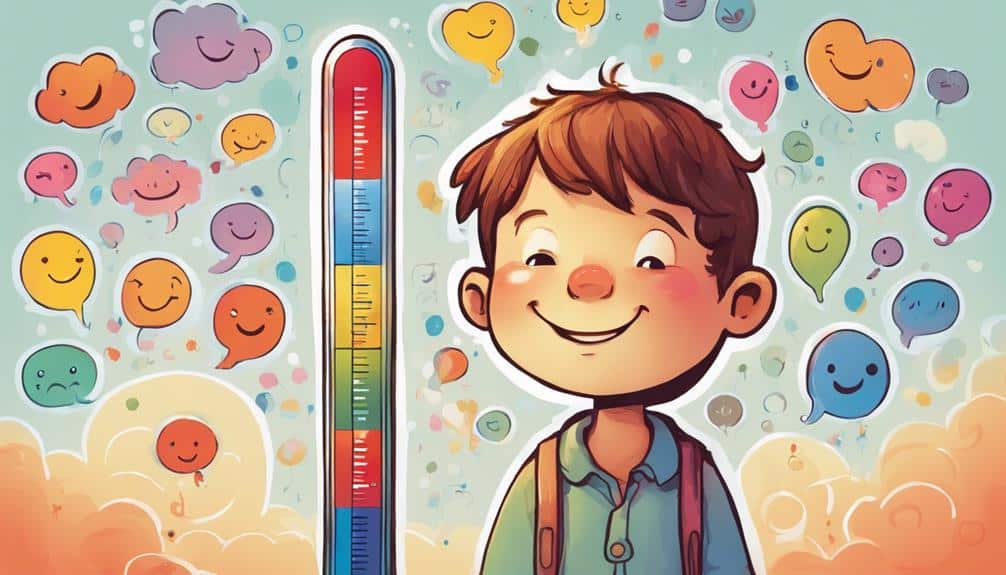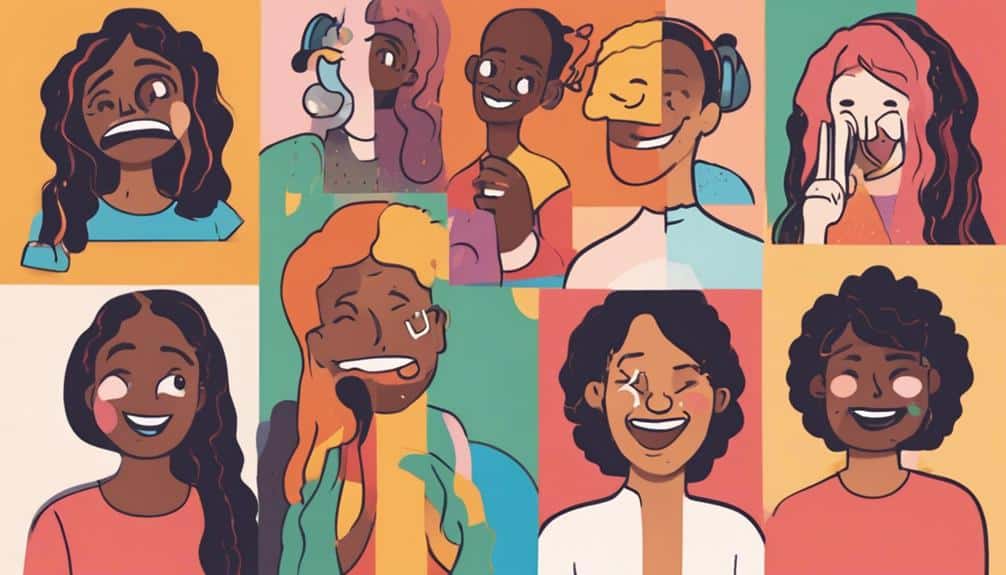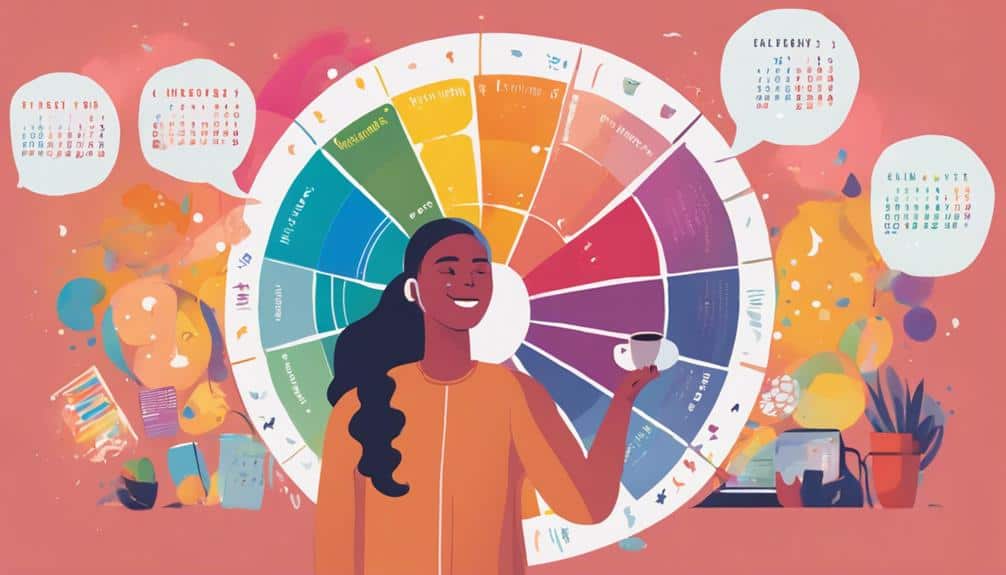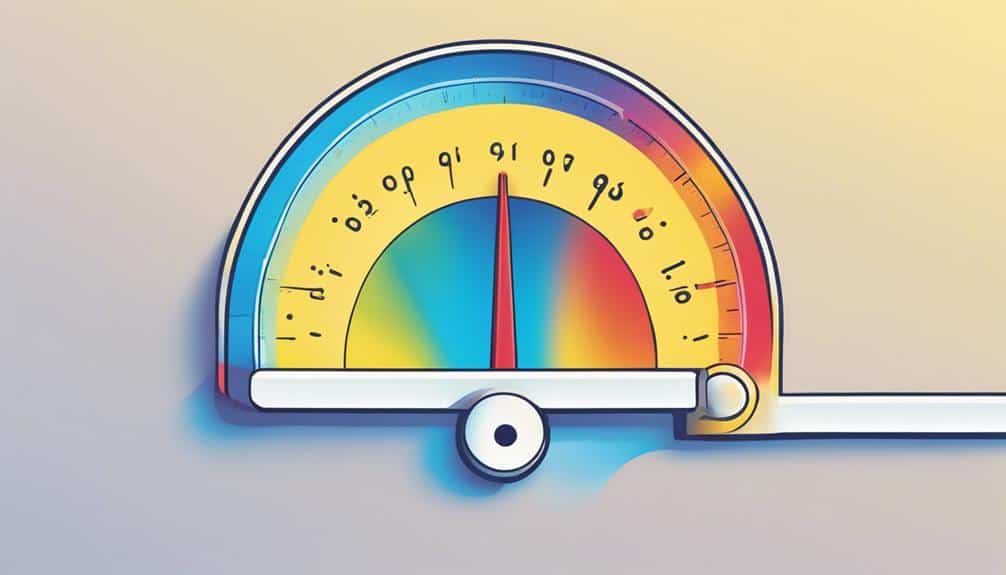You're likely familiar with being asked 'How are you feeling?' but struggle to articulate your emotions, which is where the How Are You Feeling Scale comes in – a powerful tool developed by Kari Dunn Buron and Mitzi Curtis to help individuals understand and manage their emotions effectively. This 5-point visual tool enhances emotional awareness and regulation through a detailed framework, empowering you to take control of your emotional well-being. By using this scale, you'll gain a better understanding of your emotions, develop self-awareness skills, and improve your relationships. As you explore this concept further, you'll uncover the full potential of the How Are You Feeling Scale.
Key Takeaways
• The How Are You Feeling Scale is a 5-point visual tool developed by Kari Dunn Buron and Mitzi Curtis to identify and manage emotions effectively.
• The scale enhances emotional awareness and regulation by providing a structured way to recognize and express emotions using numbers, faces, and actions.
• It empowers individuals to take control of their emotional well-being by acknowledging internal signals, identifying triggers, and implementing coping strategies.
• The scale aids in recognizing emotional states and differentiating feelings, leading to better decision-making, improved relationships, and enhanced emotional intelligence.
• By using the scale, individuals can develop self-awareness skills, regulate emotions, and cultivate healthy coping mechanisms, leading to improved mental health and relationships.
Understanding Emotional Intelligence
Emotional intelligence, an essential component of personal and professional success, involves understanding and managing your own emotions and recognizing and empathizing with others' emotions.
To develop emotional intelligence, you need to recognize emotions – both yours and others'. This self-awareness is critical in making informed decisions and building strong relationships. By being aware of your emotions, you can better manage them, making you more effective in your personal and professional life.
Emotional intelligence also involves social awareness, which enables you to recognize and empathize with others' emotions. This skill is important in building strong relationships, resolving conflicts, and making better decisions.
Effective relationship management is another key aspect of emotional intelligence. By understanding others' emotions and needs, you can navigate complex social situations and build stronger, more meaningful relationships.
Cultivating emotional intelligence can have a significant impact on your overall well-being and success. By developing your emotional intelligence, you can improve your mental health, relationships, and decision-making abilities, ultimately leading to greater personal and professional success.
Origins of the Feeling Scale

As you explore the Origins of the Feeling Scale, you'll discover the early development stages that laid the groundwork for this influential tool.
You'll learn how the inception of measurement led to a simple yet effective method for expressing emotions.
Early Development Stages
Developed by pioneers in emotional intelligence, Kari Dunn Buron and Mitzi Curtis, the How Are You Feeling Scale evolved from a simple yet all-encompassing concept: a 5-point visual tool designed to help children (and ultimately, individuals of all ages) understand and communicate their emotions effectively.
This innovative approach aimed to provide a structured way for you to identify and express your feelings using numbers, faces, and corresponding actions.
During the early development stages, the focus was on creating a simple yet all-inclusive system that could be easily understood and utilized by children of all ages. You learn how to recognize and navigate your emotions through a detailed framework, which enhances emotional awareness and regulation.
The 5-point scale is designed to help one person at a time, providing a clear and constructive way to express and manage feelings. By incorporating numbers, faces depicting different emotions, and actionable steps, the scale empowers individuals to take control of their emotional well-being.
The origins of the Feeling Scale emphasize the importance of providing a detailed framework for individuals to navigate and express their emotions.
Inception of Measurement
You can trace the origins of the Feeling Scale back to the need for a standardized system that would help individuals, particularly children, quantify and describe their emotions. This innovative approach aimed to provide a structured way to express emotions, ranging from positive to negative states.
The Feeling Scale's inception was driven by the desire to promote emotional awareness, self-regulation, and communication skills in individuals of all ages. By using numbers and visuals to represent different emotional states, the scale offers a unique tool to assist individuals in recognizing and managing their feelings.
That's okay if you're not sure how you're feeling – the scale is designed to help you figure it out. If you’re feeling a mix of emotions, that’s perfectly normal too. The scale can still be a useful tool for identifying the different emotions you’re experiencing. And if you’re experiencing dizziness when you bend over, here are some tips for stopping dizziness when bending: Try to pace yourself and avoid sudden movements, stay hydrated, and practice deep breathing exercises to help regulate your blood pressure and reduce dizziness.
The scale's development was a response to the need for a more effective way to identify and communicate emotions, especially in children. By providing a standardized system, the Feeling Scale has become an essential tool in promoting emotional intelligence and well-being.
Historical Context Matters
In the 1990s, Dr. John E. Calamia pioneered the concept of the Feeling Scale, tailoring it to help individuals with autism spectrum disorder (ASD) better navigate and express their emotions.
You might wonder why this innovation was necessary. At the time, individuals with ASD struggled to identify and communicate their emotions, leading to difficulties in social interactions and emotional regulation. Dr. Calamia's groundbreaking work addressed this need by developing a visual and tactile scale that could assist individuals in identifying and expressing their feelings through a structured and accessible format.
How Emotions Affect Behavior

Emotions serve as a powerful catalyst, influencing your behavior and shaping your reactions to the world around you. As you navigate through life, your emotional state plays a significant role in determining how you respond to various situations.
By understanding the How Are You Feeling Scale, you can better comprehend the connection between your emotions and behavior. This awareness allows you to predict and manage your reactions, making more thoughtful decisions and avoiding impulsive behaviors.
Recognizing the emotional drivers behind your actions is essential for fostering self-awareness and promoting healthy coping strategies. When you're aware of your emotional state, you can take steps to regulate your emotions, leading to more constructive interactions and relationships.
By acknowledging the impact of emotions on behavior, you can develop a deeper understanding of yourself and those around you. This understanding can lead to more effective communication, improved relationships, and a more harmonious environment.
Identifying Body Cues and Triggers

Many physical sensations, such as a racing heart or a knot in the stomach, serve as body cues that signal different emotional states, making it essential to recognize and understand these internal alerts. By paying attention to these cues, you can better comprehend your emotional responses and take proactive steps to regulate your feelings.
Triggers, such as specific events or interactions, can also contribute to heightened emotional responses. Identifying these triggers can help you prepare for and manage your emotions in challenging situations.
Recognizing your body cues and triggers can empower you to navigate emotional situations with greater self-awareness. By acknowledging these internal signals, you can implement coping strategies to regulate your emotions and respond more thoughtfully to triggers.
This awareness can also help you develop more effective emotional regulation skills, leading to improved emotional intelligence. By understanding the connection between body cues, triggers, and emotional responses, you can cultivate a deeper understanding of yourself and develop more effective strategies for managing your emotions.
Developing Self-Awareness Skills

You can develop self-awareness skills by recognizing and understanding your emotional states, which is essential for effectively managing your emotions and behaviors.
By using the How Are You Feeling Scale, you'll become more aware of your emotional landscape and learn to differentiate between various feelings and their intensity levels. This increased self-awareness enables you to recognize the physical cues and triggers associated with different emotions, allowing you to better understand what you're feeling and why.
As you develop self-awareness, you'll become more adept at regulating your emotions and choosing appropriate coping strategies. You'll learn to acknowledge and express your feelings in a healthy, constructive way, which is pivotal for building strong relationships and achieving emotional well-being.
Additionally, self-awareness empowers you to seek support when needed, fostering a sense of confidence and resilience. By cultivating self-awareness through the How Are You Feeling Scale, you'll open the door to emotional intelligence, paving the way for personal growth and success.
Teaching Emotional Regulation

By introducing the How Are You Feeling Scale in educational settings, educators can empower children to recognize, understand, and regulate their emotions, ultimately fostering a supportive and emotionally aware classroom environment. This visual tool helps children differentiate between manageable and overwhelming feelings, allowing them to express and address their emotions effectively.
Teaching emotional regulation through the scale involves educating students on recognizing different levels of emotional intensity and corresponding behaviors. This enables children to identify triggers, recognize body cues, and develop coping strategies to manage their emotions constructively.
Here's a breakdown of how the scale can be used to teach emotional regulation:
| Emotional Regulation Skill | How the Scale Helps |
|---|---|
| Recognizing emotional intensity | Identifies different levels of emotional intensity |
| Identifying triggers | Helps children recognize what triggers their emotions |
| Recognizing body cues | Teaches children to recognize physical sensations associated with emotions |
| Developing coping strategies | Encourages children to develop constructive ways to manage emotions |
| Expressing emotions effectively | Empowers children to express their emotions effectively |
Building Healthy Coping Strategies

An indispensable aspect of emotional regulation is developing a repertoire of healthy coping strategies that can help mitigate the impact of stress and negative emotions on daily life. You can cultivate these strategies to manage your emotions and stress in a positive way.
Activities like deep breathing, mindfulness, exercise, and seeking social support can become your go-to tools for emotional regulation. Engaging in self-care practices, setting boundaries, and expressing emotions through creative outlets are also key components of healthy coping.
By building these strategies, you can enhance your resilience, emotional intelligence, and overall well-being. It's vital to teach children and adults alike how to cultivate healthy coping strategies, as this is necessary for developing effective emotional regulation skills.
Customizing the Feeling Scale

As you customize the feeling scale, you'll experience an emotional intelligence boost by recognizing your unique emotional patterns.
By creating a personalized emotional scale, you'll better understand your contextual feeling states, which will help you respond to emotions more effectively.
Emotional Intelligence Boost
Customizing the feeling scale to fit your unique emotional landscape can greatly enhance your emotional intelligence, allowing you to better understand and navigate your feelings. By tailoring the scale to your individual needs, you can develop a deeper understanding of your emotional triggers and responses. This, in turn, can empower you to take proactive steps towards self-regulation and emotional well-being.
Here are just a few ways that customizing the feeling scale can boost your emotional intelligence:
- Increase self-awareness: By identifying and labeling your unique emotions, you can gain a better understanding of your emotional landscape and develop a more nuanced sense of self.
- Improve emotional expression: A personalized feeling scale can help you express your emotions more effectively, allowing you to communicate your needs and feelings to others.
- Enhance emotional regulation: By understanding your emotional triggers and responses, you can develop targeted coping strategies to manage your emotions and achieve emotional balance.
Personalized Emotional Scale
By tailoring the Feeling Scale to your unique emotional landscape, you can create a personalized emotional scale that effectively captures your emotional experiences and coping strategies.
You can customize the scale by downloading printable templates, such as the 'I am OK' and 'I am Happy' 5 Point Scales. These templates often feature columns for numbers, facial expressions of feelings, visual representations, and action steps for different emotional states.
To make the scale truly yours, add specific coping strategies or activities that help regulate emotions at each level. For instance, if taking a walk helps you calm down when you're anxious, include that in your scale.
You can also incorporate individualized prompts, such as deep breathing or using sensory tools, to encourage self-awareness and emotional regulation. By empowering yourself to tailor the scale to your unique needs, preferences, and coping mechanisms, you'll be better equipped to manage different emotional intensities.
This personalized approach allows you to develop a deeper understanding of your emotions and develop effective strategies to navigate them.
Contextual Feeling States
You can create a highly nuanced and effective Feeling Scale by contextualizing your emotional states, incorporating specific emotions, triggers, and coping strategies that resonate with your individual experiences. This personalized approach allows you to tailor the scale to address specific emotional states, such as anxiety, excitement, frustration, or sadness, based on your personal triggers and reactions.
To take it a step further, consider the following contextual factors to enhance your Feeling Scale:
- Incorporate sensory tools: Utilize sensory experiences, such as deep breathing, visualization, or physical exercise, to help you regulate and manage your emotions.
- Identify unique body cues: Recognize your individual physical responses to emotions, such as a racing heart or tense muscles, to better understand your emotional states.
- Develop self-regulation techniques: Incorporate strategies like mindfulness, journaling, or talking to a trusted friend to help you navigate complex emotional states.
Implementing in Daily Life

To seamlessly integrate the How Are You Feeling Scale into your daily routine, start by designating a specific time each day to reflect on your emotional state. This can be as simple as taking a few minutes each morning or before bed to assess how you're feeling. By doing so, you'll become more attuned to your emotions and better equipped to manage them.
| Emotion | Action |
|---|---|
| Calm | Practice mindfulness exercises to maintain equilibrium |
| Frustrated | Take a short break to relax and recharge |
| Anxious | Engage in deep breathing exercises to calm down |
| Overwhelmed | Reach out to a trusted friend or mental health professional for support |
Benefits for Children and Adults

The How Are You Feeling Scale offers a multitude of benefits for both children and adults, empowering them to develop a deeper understanding of their emotions and cultivate healthier emotional regulation strategies. By using the scale, you can identify and communicate your emotions effectively, recognizing different levels of emotional intensity from calm to overwhelmed.
The benefits of the How Are You Feeling Scale include:
- Improved emotional awareness: You'll gain a deeper understanding of your emotions and develop self-awareness, allowing you to recognize patterns and triggers.
- Enhanced emotional regulation: You'll learn to cope with your emotions in a healthy way, developing strategies to manage feelings of anxiety, anger, or sadness.
- Effective communication: You'll be able to articulate your emotions to others, improving relationships and reducing conflicts.
Overcoming Emotional Challenges

As you develop a deeper understanding of your emotions through the How Are You Feeling Scale, you're better equipped to tackle emotional challenges that may arise. You'll be more likely to recognize when you need support and take proactive steps to address emotional difficulties.
For instance, when faced with feelings of loneliness and anxiety, you might seek out a support system or engage in therapy sessions to work through those emotions.
By prioritizing self-care, you can develop effective coping strategies to navigate tough emotions. This might involve activities that bring you joy, such as watching movies or spending time with friends.
You might also recognize the importance of counseling sessions, which can provide a safe and supportive environment to process your emotions.
Real-Life Applications and Scenarios

You can apply the How Are You Feeling Scale in various real-life scenarios, such as in classrooms, at home, or during social interactions, to help individuals identify and communicate their emotions effectively. This tool provides a structured way for you to express your feelings, leading to better self-awareness and emotional regulation. By using the scale, you can learn to recognize, understand, and respond to your feelings in a healthy and constructive manner.
Here are some ways you can apply the How Are You Feeling Scale in real-life scenarios:
- In classrooms, teachers can use the scale to help students identify and manage their emotions, leading to a more productive and focused learning environment.
- At home, parents can use the scale to support children in developing emotional awareness and regulation skills, leading to better relationships and reduced conflicts.
- During social interactions, the scale can help you communicate your emotions effectively, leading to more meaningful and empathetic relationships.
Integrating With Mental Health Practices

As you explore the integration of the How Are You Feeling Scale with mental health practices, you'll discover the benefits of incorporating mindful self-assessment tools into your care routine.
By doing so, you'll be able to better understand your emotional landscape and develop a more holistic approach to wellness.
This integration will empower you to prioritize your emotional well-being and cultivate healthy coping mechanisms.
Mindful Self-Assessment Tools
By incorporating mindful self-assessment tools, like the 'How Are You Feeling Scale', into mental health practices, individuals can develop a deeper understanding of their emotional landscapes and take proactive steps towards improved well-being.
As you integrate these tools into your daily routine, you'll become more aware of your emotional states, triggers, and coping strategies. This increased self-awareness enables you to make informed decisions about your mental health, fostering a culture of emotional transparency and support.
Here are just a few benefits of incorporating mindful self-assessment tools into your mental health practices:
- Improved emotional regulation: By recognizing your emotions, you can develop healthier coping mechanisms and respond to challenging situations more effectively.
- Enhanced self-care: By pinpointing your emotional states, you can tailor your self-care routine to meet your specific needs, leading to improved overall well-being.
- Increased mental health awareness: By fostering a culture of emotional transparency, you can break down stigmas surrounding mental health and encourage open conversations about emotional struggles.
Holistic Wellness Approaches
Integrating the 'How Are You Feeling Scale' into mental health practices paves the way for a more all-encompassing approach to wellness, one that addresses both emotional and mental health needs. By incorporating this scale into your daily routine, you can develop a deeper understanding of your emotional states and improve your self-awareness.
This integration enables you to identify and communicate your feelings more effectively, leading to better emotional regulation and management. As you track your emotional fluctuations, you'll begin to recognize triggers and develop coping strategies to navigate challenging situations.
The 'How Are You Feeling Scale' serves as a valuable tool for promoting mental well-being, fostering self-care practices, and encouraging open communication about emotions. By combining this scale with mental health practices, you'll be able to adopt a holistic approach to wellness, addressing both emotional and mental health needs.
This holistic approach empowers you to take control of your emotional and mental well-being, leading to a more balanced and fulfilling life.
Frequently Asked Questions
How Are You Feeling on the 5 Point Scale?
When someone asks 'how are you feeling on the 5-point scale?', you're being invited to reflect on your emotional state. Take a moment to assess your feelings, considering your body cues and thoughts.
Are you feeling calm and focused, or overwhelmed and anxious? Be honest with yourself, and identify which level best describes your emotional intensity.
This self-awareness is the first step in managing your emotions and finding ways to regulate them effectively.
What Is the Scale for Measuring Feelings?
Imagine you're 8-year-old Emma, struggling to put your emotions into words after a frustrating day. That's where the feelings scale comes in – a visual tool measuring emotions from 1 (small feelings like happy) to 5 (big feelings like angry or anxious).
This scale helps you identify and communicate your emotions, recognizing intensity, behaviors, and body cues associated with each level. By using this scale, you'll better understand and express your feelings, taking the first step towards emotional well-being.
What Is a Feelings Scale?
You're wondering what a feelings scale is. Simply put, it's a tool that helps you identify and communicate your emotions at different intensity levels.
Imagine a visual representation with various points or levels, ranging from smaller, manageable feelings to bigger, overwhelming emotions.
How Do You Explain How You Feel?
When you're asked how you feel, take a moment to reflect. Identify the emotions swirling inside you. Are you feeling happy, sad, or maybe frustrated?
Try to pinpoint the intensity of your emotions, too. Are they mild, moderate, or intense?
Once you've tuned in, use words or visual aids to express yourself. You can even create your own personalized scale to help you communicate your emotions effectively.



